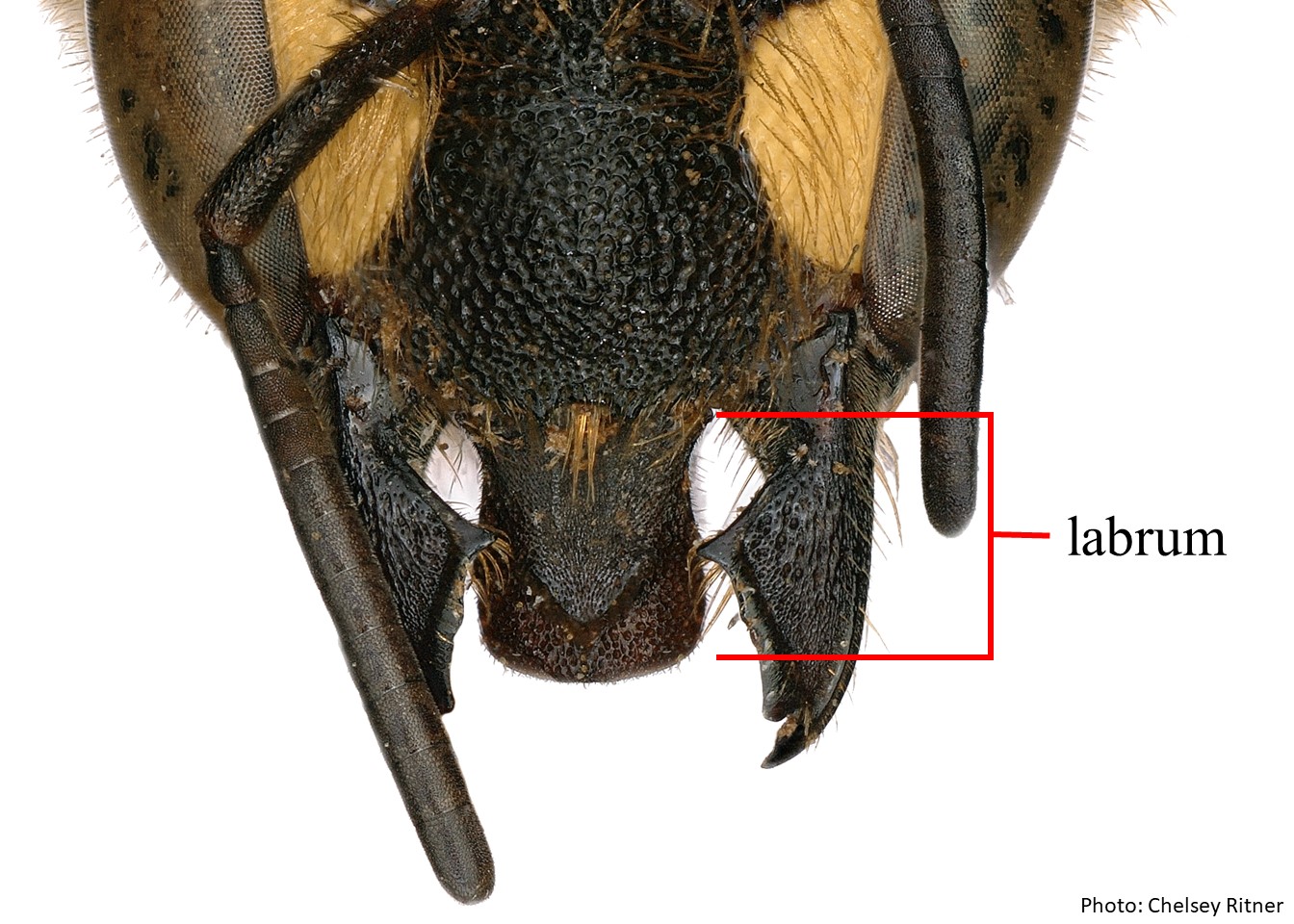Family: Megachilidae
Subfamily: Megachilinae
Tribe: Anthidiini
Genus: Anthidium Fabricius, 1804
Subgenus: A. (Anthidium) Fabricius, 1804
Species: Anthidium multispinosum Gonzalez and Griswold, 2013
Common name: none
Anthidium (Anthidium) multispinosum are black with yellow maculations and reddish-brown coloration on the tarsitarsi:
the group of segments at the end of the leg following the tibia
, T6T6:
the segments on the top side of the abdomen, often abbreviated when referring to a specific segment to T1, T2, T3, T4, T5, T6, or T7 discdisc:
discdisc:
a generic term for the middle surface of a plate (usually in reference to an abdominal segment)
, laterally on S1S1:
the plates on the underside of the abdomen, often abbreviated when referring to a specific segment to S1, S2, S3, S4, S5, S6, S7, or S8
 , and medially on S6S6:
, and medially on S6S6:
the plates on the underside of the abdomen, often abbreviated when referring to a specific segment to S1, S2, S3, S4, S5, S6, S7, or S8
 (Gonzalez and Griswold 2013Gonzalez and Griswold 2013:
(Gonzalez and Griswold 2013Gonzalez and Griswold 2013:
Gonzalez, V.H. and T.L. Griswold. 2013. Wool carder bees of the genus Anthidium in the Western Hemisphere (Hymenoptera: Megachilidae): diversity, host plant associations, phylogeny, and biogeography. Zoological Journal 168: 221ndash;425.). Anthidium multispinosum have white pubescencepubescence:
short, fine hair
except for brown to light ferruginousferruginous:
rust-colored
hairs on the inner hind tarsitarsi:
the group of segments at the end of the leg following the tibia
and centers of S3–S6. Anthidium multispinosum are only known from a single female specimen, which has a body length of 10.5 mm (Gonzalez and Griswold 2013Gonzalez and Griswold 2013:
Gonzalez, V.H. and T.L. Griswold. 2013. Wool carder bees of the genus Anthidium in the Western Hemisphere (Hymenoptera: Megachilidae): diversity, host plant associations, phylogeny, and biogeography. Zoological Journal 168: 221ndash;425.).
(modified from Gonzalez and Griswold 2013Gonzalez and Griswold 2013:
Gonzalez, V.H. and T.L. Griswold. 2013. Wool carder bees of the genus Anthidium in the Western Hemisphere (Hymenoptera: Megachilidae): diversity, host plant associations, phylogeny, and biogeography. Zoological Journal 168: 221ndash;425.)
 is elevated basally and has two large preapicalpreapical:
is elevated basally and has two large preapicalpreapical: distaldistal:
distaldistal: lacks a preapicalpreapical:
lacks a preapicalpreapical:Anthidium multispinosum can be easily distinguished from all Anthidium species in the U.S. by the four spines on the apicalapical:
near or at the apex or end of any structure
margin of T6T6:
the segments on the top side of the abdomen, often abbreviated when referring to a specific segment to T1, T2, T3, T4, T5, T6, or T7 and the well-developed apicalapical:
and the well-developed apicalapical:
near or at the apex or end of any structure
spine on the outer surface of the mid tibiatibia:
the segment of the leg, between the femur and the tarsus.
Anthidium multispinosum adults have been recorded in flight in March (Gonzalez and Griswold 2013Gonzalez and Griswold 2013:
Gonzalez, V.H. and T.L. Griswold. 2013. Wool carder bees of the genus Anthidium in the Western Hemisphere (Hymenoptera: Megachilidae): diversity, host plant associations, phylogeny, and biogeography. Zoological Journal 168: 221ndash;425.).
Floral associations are unknown.
Nesting behavior is unknown.
Anthidium multispinosum is known from a single specimen from Durango, Mexico in the southern Chihuahuan Desert (Gonzalez and Griswold 2013Gonzalez and Griswold 2013:
Gonzalez, V.H. and T.L. Griswold. 2013. Wool carder bees of the genus Anthidium in the Western Hemisphere (Hymenoptera: Megachilidae): diversity, host plant associations, phylogeny, and biogeography. Zoological Journal 168: 221ndash;425.). None are known to occur in the U.S. or Canada.
Distribution map generated by Discover Life -- click on map for details, credits, and terms of use.
Gonzalez, V.H. and T.L. Griswold. 2013. Wool carder bees of the genus Anthidium in the Western Hemisphere (Hymenoptera: Megachilidae): diversity, host plant associations, phylogeny, and biogeography. Zoological Journal of the Linnean Society 168: 221-425.